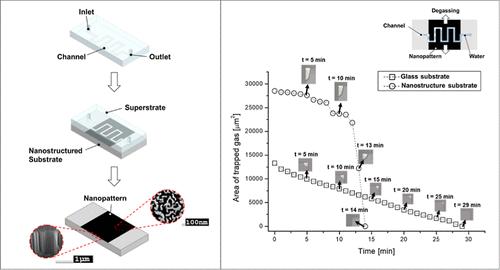Our official English website, www.x-mol.net, welcomes your feedback! (Note: you will need to create a separate account there.)
Nanostructured Substrate-Mediated Bubble Degassing in Microfluidic Systems
Langmuir ( IF 3.9 ) Pub Date : 2024-04-08 , DOI: 10.1021/acs.langmuir.4c00359 Sanghyun Lee 1 , Hyewon Kim 2 , Hyewon Lim 2 , Yejin Nam 1 , Sangmin Lee 1 , Hyungmo Kim 2
Langmuir ( IF 3.9 ) Pub Date : 2024-04-08 , DOI: 10.1021/acs.langmuir.4c00359 Sanghyun Lee 1 , Hyewon Kim 2 , Hyewon Lim 2 , Yejin Nam 1 , Sangmin Lee 1 , Hyungmo Kim 2
Affiliation

|
Microfluidic platforms have been widely used in a variety of fields owing to their numerous advantages. The prevention and prompt removal of air bubbles from microchannels are important to ensuring the optimal functioning of microfluidic devices. The entrapment of bubbles in the microchannels can result in flow instability and device performance disruption. Active and passive methods are the primary categories of degassing technologies. Active methods rely on external equipment, and passive methods operate autonomously without any external sources. This study proposed a passive degassing method that employs a nanoscale surface morphology integrated into the substrate of a microfluidic device. Nanostructures exhibit a microchannel geometry and are fabricated based on surface micromachining technology using silver ink and chemical etching. Consequently, the gas permeability is enhanced, resulting in effective degassing through the nanostructure. The performance of this degassing method was characterized under varying substrate permeabilities and input pressure conditions, and it was found that increased permeability facilitates the degassing performance. Furthermore, the applicability of our method was demonstrated by using a serpentine channel design prone to gas entrapment, particularly in the corner regions. The nanostructured substrate exhibited significantly improved degassing performance under the given pressure conditions in comparison to the glass substrate.
中文翻译:

微流体系统中纳米结构基底介导的气泡脱气
微流控平台因其众多的优点而被广泛应用于各个领域。防止和及时清除微通道中的气泡对于确保微流体装置的最佳功能非常重要。微通道中的气泡截留会导致流动不稳定和设备性能破坏。主动和被动方法是脱气技术的主要类别。主动方法依赖外部设备,被动方法无需任何外部源即可自主运行。这项研究提出了一种被动脱气方法,该方法采用集成到微流体装置基板中的纳米级表面形态。纳米结构呈现出微通道几何形状,并基于使用银墨水和化学蚀刻的表面微加工技术制造。因此,透气性增强,从而通过纳米结构有效脱气。该脱气方法的性能在不同的基材渗透率和输入压力条件下进行了表征,结果发现渗透率的增加有利于脱气性能。此外,我们的方法的适用性通过使用容易滞留气体的蛇形通道设计得到了证明,特别是在角落区域。与玻璃基板相比,纳米结构基板在给定压力条件下表现出显着改善的脱气性能。
更新日期:2024-04-08
中文翻译:

微流体系统中纳米结构基底介导的气泡脱气
微流控平台因其众多的优点而被广泛应用于各个领域。防止和及时清除微通道中的气泡对于确保微流体装置的最佳功能非常重要。微通道中的气泡截留会导致流动不稳定和设备性能破坏。主动和被动方法是脱气技术的主要类别。主动方法依赖外部设备,被动方法无需任何外部源即可自主运行。这项研究提出了一种被动脱气方法,该方法采用集成到微流体装置基板中的纳米级表面形态。纳米结构呈现出微通道几何形状,并基于使用银墨水和化学蚀刻的表面微加工技术制造。因此,透气性增强,从而通过纳米结构有效脱气。该脱气方法的性能在不同的基材渗透率和输入压力条件下进行了表征,结果发现渗透率的增加有利于脱气性能。此外,我们的方法的适用性通过使用容易滞留气体的蛇形通道设计得到了证明,特别是在角落区域。与玻璃基板相比,纳米结构基板在给定压力条件下表现出显着改善的脱气性能。



























 京公网安备 11010802027423号
京公网安备 11010802027423号